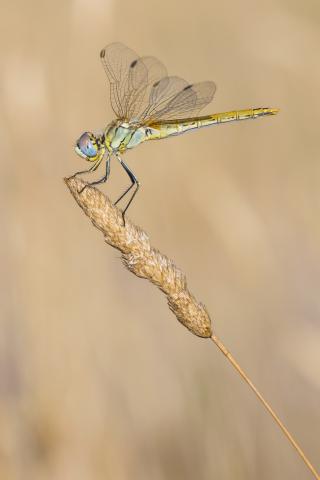How does the dragon fly?
I’m writing this during the cold months in East Tennessee. There are no dragonflies zipping about. They tend to be more active during the warmer months.
I’ve noticed that, in addition to warm weather, dragonflies like water. As a young kid, I learned that if you go out into your yard on a hot, dry, summer day and spray water from a garden hose up into the air to form a mist, you just might attract a dragonfly or two. Try it some hot and dusty afternoon this coming August. Maybe a shimmering visitor will appear.
Dragonflies are interesting not only due to their iridescent, beautiful design, but also due to their ability to zoom around so rapidly and with such agility. They are true aerial acrobats. Sometimes, it seems as though they are flying at speeds they should not be able to attain given their gossamer construction.
Here’s a shocker. They actually should not be able to fly so fast—but they do anyway, much to the envy of every other insect on the planet. Dragonflies are the flying bug speed champs, topping out around a scorching 35 miles per hour. How do they do that without ripping their wings apart?
Dragonflies have a secret weapon. They have to beat their four wings about thirty times per second in order to generate enough velocity to catch flying prey like mosquitoes. Having pairs of wings so close to each other while flapping so quickly can potentially stir up a lot of air turbulence. Turbulence could severely hamper the dragonfly’s ability to move forward at a high rate of speed. It could, that is, if it were there.
Scientists studying dragonflies have identified an interesting feature at the leading edges of their wings. Take a close look at the picture at the top of this article. See that little dark spot on each wing? That little spot is known as the pterostigma. There’s pigment in that little spot that acts as a weight.
Even though a dragonfly’s wing weighs practically nothing, it does have mass. When you start vibrating a surface quickly in the air, that mass starts to flex and generate turbulence. In turn, that turbulence interferes with the productivity of all of the bug’s flapping.
At top speed, without the turbulence being mitigated, the poor dragonfly’s wings would indeed be torn apart. The tiny weight of the pterostigmata (that’s the plural form of pterostigma) is enough to change the center of mass along the wing and eliminate the excessive vibrations caused by frantic flapping.
It’s kind of like how a mechanic might balance your car’s wheels by clamping those little lead weights around the edges of the rims.
The construction of the dragonfly wing is an astonishing feat of intelligent design that makes the lovely critter a master of the air and an effective exterminator of troublesome insects like mosquitos. Dragonflies are definitely our friends.
Their mysterious omnidirectional flight capability and their stunning beauty have captured our collective imagination for centuries. My grandmother used to call them “snake doctors” when I was a small child, walking hand in hand with her through her country backyard.
There has been a myth around for hundreds of years that a dragonfly could breathe life into a dead snake, giving rise to the curious nickname. I’m not sure where that came from, and it’s definitely not true, but it speaks to the mystery around these speedy, helpful, and ingeniously designed creatures.
This article was written by Tilmer Wright, Jr. Tilmer is an IT professional with over thirty years of experience wrestling with technology and a proud member of the Authors Guild of Tennessee. In his spare time, he writes books. You can find links to his books on Amazon or at TilmerWrightJr.com
- Log in to post comments

Dragonflies
Thanks for the information, Tilmer. I really didn't know all those wonderful facts!